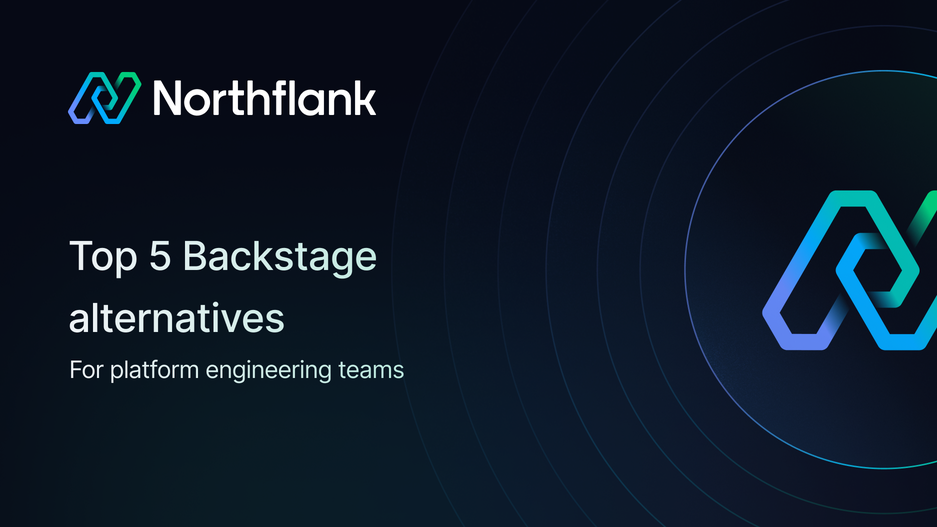

Top 5 Backstage alternatives for platform engineering teams in 2025
Backstage has become the go-to framework for teams building internal developer portals, but its open-source nature comes with significant implementation and maintenance demands.
This guide covers five alternatives to Backstage, comparing their technical approaches, implementation requirements, and use cases to help you find the right solution for your team.
-
Northflank – Complete unified platform that builds, deploys, and runs your infrastructure while providing centralized visibility.
Unlike Backstage's approach, Northflank handles workload execution with CI/CD, deployment automation, and infrastructure management included. Deploy apps, databases, jobs, and GPU workloads through a unified interface in minutes.
-
Cycloid – Portal and platform combining GitOps infrastructure automation with FinOps and GreenOps monitoring. Deploys infrastructure with governance controls.
-
Port – No-code internal developer portal with customizable blueprints.
-
Cortex – Commercial developer portal for service ownership and standards enforcement with scorecards and engineering metrics.
-
OpsLevel – Internal developer portal with automated catalog maintenance using AI-powered updates.
Understanding this distinction is essential when evaluating Backstage alternatives.
Developer portals like Backstage, Port, Cortex, and OpsLevel provide centralized views of your services. They display service catalogs, documentation, and metadata about your infrastructure.
Portals help teams discover services, find owners, access documentation, and understand dependencies. They catalog and display information but don't directly build code, deploy applications, or run infrastructure. Some can trigger actions in other tools through webhooks or APIs, but the actual execution happens in separate systems.
Deployment platforms like Northflank also provide centralized views, but go further by running your workloads. They build code from repositories, deploy containers, provision databases, manage networking, and handle scaling. These platforms both display and execute infrastructure operations, giving you a unified interface for managing and operating your services.
When choosing a Backstage alternative, first determine if you need a portal for visibility, a platform for deployment and operations, or a solution offering both.
Understanding your specific requirements helps narrow down the right solution.
- Implementation timeline – How quickly can your team deploy and start using the platform? Options range from immediate deployment to several months of configuration.
- Maintenance requirements – Who maintains the platform long-term? Open-source frameworks require dedicated engineering teams while commercial solutions provide ongoing maintenance.
- Actual capabilities – Does the solution just display information or does it execute infrastructure operations? This fundamental distinction determines what problems it solves.
- Developer adoption factors – Will your developers use this platform? Interface quality, ease of use, and value delivered directly impact adoption rates.
- Integration approach – Does the solution integrate with existing tools or replace them? Determine if it orchestrates your current infrastructure or requires migration.
- Team expertise – What technical skills does implementation require? Some solutions need React expertise, others work with your existing knowledge base.
- Cost structure – What's the total cost, including engineering time? Account for licensing, implementation effort, and ongoing maintenance when comparing options.
The following solutions represent different approaches to solving developer platform challenges, from complete execution platforms to specialized portal frameworks.
Northflank provides a fundamentally different approach from Backstage. Backstage helps you organize, discover, and document your services. Northflank does that too, but also runs your actual infrastructure.
How Northflank differs from Backstage
Backstage is a framework for building portals that show you what services exist, who owns them, and where to find documentation. It provides visibility into your infrastructure. You still need separate tools to build code, deploy applications, manage databases, and handle scaling.
Northflank is a complete platform that provides visibility and executes your workloads. Connect your repository and Northflank automatically builds containers, deploys to production, provisions databases, configures networking, and handles scaling (all while giving you real-time monitoring, logging, and observability). It both displays and manages your infrastructure with full self-service capabilities for developers.
Key capabilities
- Multi-cloud deployment – Deploy to Northflank's managed cloud or connect your own GKE, EKS, AKS, Civo, OKE, or bare-metal Kubernetes clusters. Bring Your Own Cloud (BYOC) provides a fully managed platform experience inside your VPC, maintaining complete control over data residency and security.
- Infrastructure management included – All essential platform capabilities come built-in: CI/CD automation, release pipelines with promotion workflows, preview environments, secrets management, monitoring and logging, autoscaling, health checks, rollbacks, and RBAC. Access everything through real-time UI, API, CLI, or JavaScript client.
Why teams choose Northflank over portal-only solutions
Teams using platforms like Backstage sometimes find they've built visibility into infrastructure they still manage through separate tools. Northflank addresses both visibility and execution in one platform.
Companies like Weights scaled to serve millions of users using Northflank, running over 10,000 AI training jobs and half a million inference runs daily without managing autoscaling or spot instance orchestration.
Other companies use Northflank as their deployment platform, making it easier than connecting multiple tools while providing more capabilities than traditional PaaS solutions.
Try Northflank's free developer sandbox | Book a demo | See pricing details
Best for: Teams needing infrastructure execution alongside visibility, organizations wanting to deploy production workloads immediately, companies running containerized applications and AI/ML workloads with GPU requirements, and teams in search of Kubernetes power without maintenance overhead.
Cycloid provides an internal developer portal with GitOps-first infrastructure automation capabilities.
Key capabilities
- GitOps-first infrastructure automation with self-service portal interface
- Service catalog with StackForms abstracting infrastructure configuration through intuitive forms
- Infrastructure deployment and application management with governance controls
- FinOps and GreenOps modules for cloud cost and carbon footprint monitoring
- Plugin system supporting official, community, and custom integrations
Best for: Teams committed to GitOps workflows, organizations prioritizing FinOps and environmental impact monitoring, and platform teams needing infrastructure-as-code automation with governance controls.
Port delivers a no-code approach to building internal developer portals with a focus on flexible catalog modeling and self-service capabilities.
Key capabilities
- Customizable blueprints for modeling data structures without coding
- No-code service catalog creation adapting to organization-specific needs
- Self-service actions using webhook backends to trigger workflows
- Scorecard systems enforcing standards across services
Best for: Teams prioritizing no-code customization and companies needing flexible catalog design without deep Kubernetes visibility requirements.
Cortex provides a commercial internal developer portal platform emphasizing service ownership and standards enforcement.
Key capabilities
- Service catalog integrating with numerous tools to centralize service information
- Production readiness scorecards tracking compliance with organizational standards
- Initiative tracking and campaigns driving improvement across teams
- Engineering intelligence metrics providing visibility into velocity, incidents, and deployment patterns
Best for: Organizations prioritizing standards enforcement, companies with a budget for commercial solutions.
OpsLevel provides an internal developer portal with focus on reducing manual overhead through automated catalog maintenance.
Key capabilities
- Automated service catalog maintenance powered by AI
- Customizable templates and built-in best practices
- Scoped scorecards for different service maturity levels
- TechDocs support for documentation hosting
Best for: Teams prioritizing automation to reduce operational overhead, organizations needing fast deployment timelines, and companies wanting catalog maintenance without manual YAML updates.
Choosing the right Backstage alternative depends on understanding what problem you're solving.
Portal-focused solutions like Port, Cortex, or OpsLevel provide service catalogs, scorecards, and self-service actions for visibility and standards enforcement.
Platforms like Northflank provide both visibility and complete infrastructure execution - handling deployment, operations, and management alongside service discovery in one unified solution.
Next steps:
- Define if you need service visibility, infrastructure execution, or both
- Assess your team's capacity for building and maintaining frameworks
- Test solutions with production workloads
- Measure potential developer adoption through user feedback
- Calculate the total cost, including engineering time investment
Start with a solution that offers both visibility and execution and also matches your technical requirements. Try Northflank's free sandbox or schedule a demo to see how a unified platform compares to portal-only solutions.